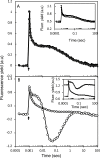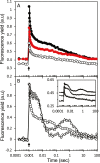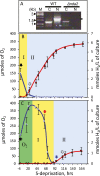Characterization of the transient fluorescence wave phenomenon that occurs during H2 production in Chlamydomonas reinhardtii
- PMID: 31504725
- PMCID: PMC6859737
- DOI: 10.1093/jxb/erz380
Characterization of the transient fluorescence wave phenomenon that occurs during H2 production in Chlamydomonas reinhardtii
Abstract
The redox state of the plastoquinone (PQ) pool in sulfur-deprived, H2-producing Chlamydomonas reinhardtii cells was studied using single flash-induced variable fluorescence decay kinetics. During H2 production, the fluorescence decay kinetics exhibited an unusual post-illumination rise of variable fluorescence, giving a wave-like appearance. The wave showed the transient fluorescence minimum at ~60 ms after the flash, followed by a rise, reaching the transient fluorescence maximum at ~1 s after the flash, before decaying back to the initial fluorescence level. Similar wave-like fluorescence decay kinetics have been reported previously in anaerobically incubated cyanobacteria but not in green algae. From several different electron and proton transfer inhibitors used, polymyxin B, an inhibitor of type II NAD(P)H dehydrogenase (NDA2), had the effect of eliminating the fluorescence wave feature, indicating involvement of NDA2 in this phenomenon. This was further confirmed by the absence of the fluorescence wave in the Δnda2 mutant lacking NDA2. Additionally, Δnda2 mutants have also shown delayed and diminished H2 production (only 23% if compared with the wild type). Our results show that the fluorescence wave phenomenon in C. reinhardtii is observed under highly reducing conditions and is induced by the NDA2-mediated electron flow from the reduced stromal components to the PQ pool. Therefore, the fluorescence wave phenomenon is a sensitive probe for the complex network of redox reactions at the PQ pool level in the thylakoid membrane. It could be used in further characterization and improvement of the electron transfer pathways leading to H2 production in C. reinhardtii.
Keywords: Chlamydomonas reinhardtii; hydrogen production; plastoquinone pool; sulfur deprivation; type II NDH; variable fluorescence.
© The Author(s) 2019. Published by Oxford University Press on behalf of the Society for Experimental Biology.
Figures











References
-
- Alric J. 2014. Redox and ATP control of photosynthetic cyclic electron flow in Chlamydomonas reinhardtii: (II) involvement of the PGR5–PGRL1 pathway under anaerobic conditions. Biochimica et Biophysica Acta 1837, 825–834. - PubMed
-
- Antal TK, Krendeleva TE, Laurinavichene TV, Makarova VV, Ghirardi ML, Rubin AB, Tsygankov AA, Seibert M. 2003. The dependence of algal H2 production on Photosystem II and O2 consumption activities in sulfur-deprived Chlamydomonas reinhardtii cells. Biochimica et Biophysica Acta 1607, 153–160. - PubMed
-
- Antal TK, Krendeleva TE, Rubin AB. 2007. Study of photosystem 2 heterogeneity in the sulfur-deficient green alga Chlamydomonas reinhardtii. Photosynthesis Research 94, 13–22. - PubMed
-
- Antal TK, Kukarskikh GP, Bulychev AA, Tyystjärvi E, Krendeleva T. 2013. Antimycin A effect on the electron transport in chloroplasts of two Chlamydomonas reinhardtii strains. Planta 237, 1241–1250. - PubMed
Publication types
MeSH terms
Substances
LinkOut - more resources
Full Text Sources

